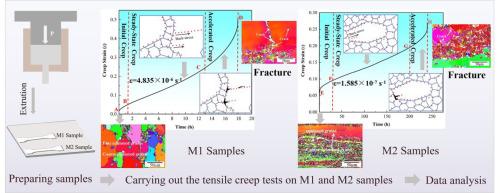当前位置:
X-MOL 学术
›
J. Magnes. Alloys
›
论文详情
Our official English website, www.x-mol.net, welcomes your
feedback! (Note: you will need to create a separate account there.)
Creep properties and fracture behavior of AZ31B extruded sheets with mixed-grain microstructures of different morphologies
Journal of Magnesium and Alloys ( IF 15.8 ) Pub Date : 2024-09-11 , DOI: 10.1016/j.jma.2024.08.013 Xiaoxia Zhang, Ming Li, Hongxia Wang, Jiao Cui, Lei Song, Naidong Ren, Lifei Wang, Weili Cheng, Kwangseon Shin
Journal of Magnesium and Alloys ( IF 15.8 ) Pub Date : 2024-09-11 , DOI: 10.1016/j.jma.2024.08.013 Xiaoxia Zhang, Ming Li, Hongxia Wang, Jiao Cui, Lei Song, Naidong Ren, Lifei Wang, Weili Cheng, Kwangseon Shin

|
In this work, AZ31B extruded sheets with mixed-grain microstructures were prepared through extrusion. Samples of mixed-grain microstructure with different morphologies were selected from the AZ31B extruded sheets (referred to as M1 and M2 samples, respectively). The creep tests were performed on these samples at the temperature range of 150–200 °C, and the stress level range of 50–100 MPa. The creep properties and fracture behavior of AZ31 extruded sheets with mixed-grain microstructures were studied. Results showed that the creep properties of the M2 sample always outperformed that of the M1 sample and M1 and M2 samples’ creep was dominated by dislocation movement. The creep rate of M2 samples (1.5 × 10-7 ± 1.1 × 10-10 s-1) is an order of magnitude lower than that of M1 samples (4.8 × 10-6 ± 8.1 × 10-10 s-1) at 200°C under 50 MPa The high activity of basal slip and softening mechanism in the M1 sample significantly accelerated creep, resulting in a relatively high creep rate. Moreover, the stress concentration within the M1 sample caused by deformation incompatibility, increased the initiation and propagation of voids, ultimately leading to fracture and poorer creep performance. However, the numerous <10 µm fine grains surrounding deformed coarse grains in the M2 sample facilitated better coordination of deformation through dislocation slip, effectively slowing down the initiation of voids during the creep process. Meanwhile, the strain was uniformly distributed within each grain, mitigating stress concentration, inhibiting voids propagation, and contributing to the superior creep resistance of the M2 sample.
中文翻译:

具有不同形态的混合晶粒微观结构的 AZ31B 挤压片材的蠕变性能和断裂行为
在本工作中,通过挤出制备了具有混合晶粒微观结构的 AZ31B 挤压片材。从 AZ31B 挤压片材中选择具有不同形态的混合晶粒微观结构样品(分别称为 M1 和 M2 样品)。在 150-200 °C 的温度范围内,在 50-100 MPa 的应力水平范围内对这些样品进行了蠕变试验。研究了具有混合晶粒微观结构的 AZ31 挤压片材的蠕变性能和断裂行为。结果表明,M2 样品的蠕变性能始终优于 M1 样品,并且 M1 和 M2 样品的蠕变以位错运动为主。在 200°C 下,在 50 MPa 下,M2 样品的蠕变速率 (1.5 × 10-7 ± 1.1 × 10-10 s-1) 比 M1 样品 (4.8 × 10-6 ± 8.1 × 10-10 s-1) 低一个数量级。M1 样品中基滑和软化机制的高活性显著加速了蠕变,导致相对较高的蠕变速率。此外,变形不相容性引起的 M1 样品内的应力集中增加了空隙的萌生和扩展,最终导致断裂和更差的蠕变性能。然而,M2 样品中变形粗晶粒周围有许多 <10 μm 细晶粒,有助于通过位错滑移更好地协调变形,有效地减缓了蠕变过程中空隙的形成。同时,应变均匀分布在每个晶粒内,减轻了应力集中,抑制了空隙的传播,并有助于 M2 样品的优异抗蠕变性。
更新日期:2024-09-11
中文翻译:

具有不同形态的混合晶粒微观结构的 AZ31B 挤压片材的蠕变性能和断裂行为
在本工作中,通过挤出制备了具有混合晶粒微观结构的 AZ31B 挤压片材。从 AZ31B 挤压片材中选择具有不同形态的混合晶粒微观结构样品(分别称为 M1 和 M2 样品)。在 150-200 °C 的温度范围内,在 50-100 MPa 的应力水平范围内对这些样品进行了蠕变试验。研究了具有混合晶粒微观结构的 AZ31 挤压片材的蠕变性能和断裂行为。结果表明,M2 样品的蠕变性能始终优于 M1 样品,并且 M1 和 M2 样品的蠕变以位错运动为主。在 200°C 下,在 50 MPa 下,M2 样品的蠕变速率 (1.5 × 10-7 ± 1.1 × 10-10 s-1) 比 M1 样品 (4.8 × 10-6 ± 8.1 × 10-10 s-1) 低一个数量级。M1 样品中基滑和软化机制的高活性显著加速了蠕变,导致相对较高的蠕变速率。此外,变形不相容性引起的 M1 样品内的应力集中增加了空隙的萌生和扩展,最终导致断裂和更差的蠕变性能。然而,M2 样品中变形粗晶粒周围有许多 <10 μm 细晶粒,有助于通过位错滑移更好地协调变形,有效地减缓了蠕变过程中空隙的形成。同时,应变均匀分布在每个晶粒内,减轻了应力集中,抑制了空隙的传播,并有助于 M2 样品的优异抗蠕变性。


















































 京公网安备 11010802027423号
京公网安备 11010802027423号